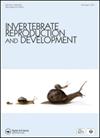两颗胎生星号海星的后代释放和父母投资程度的时间模式——照顾后代的棘皮动物的松养动物和后代大小变化概述
IF 0.8
4区 生物学
Q4 REPRODUCTIVE BIOLOGY
引用次数: 1
摘要
摘要记录了两种胎生星形海星在生殖腺中孵化幼崽的时间模式。Parvulastra parvivipara在1-5个队列中释放幼体(400-3000µm直径)。无论成虫的体型大小,亲本都能繁殖出体型较大的幼体(bbb10 000-µm)。释放的幼崽比保留的幼崽大。大多数子宫隐雄虫的后代在一窝大小相似的幼崽中被释放(平均直径732µm)。在最初的释放之后,大的稚虫(平均直径944µm)出现在子宫纹瓢虫的性腺中,这表明它们受到营养萎缩的支持,可能是通过同胞同类相食。利用营养不良指数(MI,幼鱼与卵干质量之比)估算了两种鱼的亲本投资程度。由于parvivipara和C. hystera的卵无法分离,我们用它们的同类体(分别为P. exigua和C. pentagona)的卵作为代理来估计MI,这是该指数首次应用于海洋无脊椎动物。不同大小类稚虫的MI值分别为597 ~ 55082和1.7 ~ 6.2。幼崽的肥大和大小变化可能是棘皮动物孵化幼崽的特征。本文章由计算机程序翻译,如有差异,请以英文原文为准。
Temporal pattern of offspring release and degree of parental investment in two viviparous asterinid sea stars with an overview of matrotrophy and offspring size variation in echinoderms that care for their offspring
ABSTRACT The temporal pattern of juvenile release by two species of viviparous asterinid sea stars that incubate their young in the gonads was documented. Parvulastra parvivipara released juveniles (400–3000 µm diameter) in 1–5 cohorts. Parents produced large juveniles (>1000-µm) irrespective of adult size. Released juveniles were larger than the retained juveniles. Most Cryptasterina hystera offspring were released in one large clutch of similarly sized juveniles (732-µm mean diameter). After this initial release, the presence of large juveniles (944-µm mean diameter) in the gonads of C. hystera indicates that they are supported by matrotrophy, potentially through sibling cannibalism. The degree of parental investment additional to the egg in both species was estimated by using a matrotrophy index (MI, the ratio of juvenile and egg dry mass). As the eggs of P. parvivipara and C. hystera could not be isolated, the eggs of their congeners (P. exigua and C. pentagona, respectively) were used as a proxy to estimate the MI, the first application of this index to a marine invertebrate. The MI ranged from 597 to 55082 in P. parvivipara and 1.7–6.2 in C. hystera for juveniles across the different size classes. Matrotrophy and size variation of offspring may be characteristics of echinoderms that incubate their young.
求助全文
通过发布文献求助,成功后即可免费获取论文全文。
去求助
来源期刊
CiteScore
1.90
自引率
0.00%
发文量
21
审稿时长
>12 weeks
期刊介绍:
Invertebrate Reproduction & Development ( IRD) presents original research on the reproductive and developmental biology of the Invertebrata, both embryonic and postembryonic. IRD welcomes papers reporting significant results obtained using new techniques. Encouraged topic areas include: aquaculture, physiology, biochemistry, functional morphology, phylogeny, behavioural and regulatory mechanisms, including genetic, endocrine and molecular studies. Papers containing qualitative descriptions of reproductive cycles and gametogenesis will not be considered. IRD is published in association with the International Society of Invertebrate Reproduction and Development.

 求助内容:
求助内容: 应助结果提醒方式:
应助结果提醒方式:


